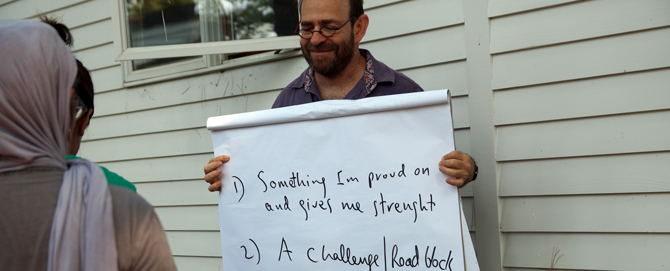Our alumni are working in ways small and large to make an impact in their communities. This “Alumni Profiles” blog series will feature some of our over 7,000 changemakers in 27 countries around the world who are working to transform conflict.
Even if you don’t recognize Hanoch’s name, chances are you’ve seen his work.
The acclaimed artist’s collages, made from found objects that play off the subject—think Freud with magnifying glasses for eyes or Einstein with a light bulb for a nose—have graced countless magazine covers and art galleries around the world.
As both a Seeds of Peace Fellow and Educator, Hanoch has led workshops at Camp and in regional programs with American, Israeli, and Palestinian youth leaders. Through his work with us, Hanoch has created a booklet outlining his method, Face to Face, allowing educators to bring his workshop to their own classrooms. We talked to Hanoch about his partnership with Seeds of Peace, Face to Face, and how teachers can use art as a tool for communication and change.
Seeds of Peace: What drew you to Seeds of Peace? And how have the workshops you’ve been doing changed as a result of working with us?
Hanoch: I’m a left-leaning Israeli frustrated by the situation and our inability to really have an impact on the situation. Seeds of Peace showed me that there was an opportunity to be involved.
On a superficial level, art is a means of communication, and Seeds of Peace is about communication. In working with Seeds of Peace, I’ve discovered that work is about reconstructing reality. About forgetting the preconception of one object, the name of the object, and seeing it suddenly in a new way.
So, it’s really about the fixed way with which our brains make us see the world, view “the other,” and behave in the world. True play and true art help us see the world in a fresh way. The connection that I see in Seeds of Peace is how it helps us break patterns.

Hanoch working with our Educators at Camp this summer.
Seeds of Peace: After working with our Educators this summer, what do you hope they will bring back to their own students?
Hanoch: I think the first thing is found on the personal level. A good educator needs to know who they are, and this workshop helps you communicate with yourself through creation. It’s like a game instead of the “real world,” and it allows you to take chances, to really be vulnerable, to really expose who you are, and the method that we use to do that is collage.
The second step is for educators to use Face to Face in their classrooms. Not—and this is very important—as art teachers. My crusade is to get the art out of the art book. To understand that art is a method of communication, just as education is about communication.
My hope is that educators can use this method in their classroom to help students grow—to understand themselves, their group, and how to communicate with other people that are very different from them or with a community very different from them. That’s very “Seeds of Peace” to me.
Seeds of Peace: Absolutely! You have all the household objects laid out for people to pick for their collages, and they’re choosing them and imbuing them with an idea about another person or about themselves. It can start a conversation that changes for the better how they understand themselves, or how they view someone else.
Hanoch: What often happens is that you choose an object, you give it meaning, and then five minutes later the same object has become something else, either because somebody else gave it a different meaning in their collage or you yourself did as you advance in your creation. This is about flexibility of thought, and the ability to be flexible grows out of the process.
Seeds of Peace: At Camp, we always tell campers to “trust the process.” It becomes the campers’ mantra.
Hanoch: Trusting the process allows us to become more flexible in how we view things that otherwise seem intractable. Like if somebody is creating a cat, and another person says that a cat doesn’t look like that, I’ll tell them, “Well, this cat does. This cat looks like that.” This cat is more important and more present than the idea of the cat you have in your brain.
Seeds of Peace: In the Face to Face video, you quote Paul Valery—
Hanoch: “To see is to forget the name of the thing one sees.”
Seeds of Peace: That quote speaks to how we have all kinds of preconceptions and all kinds of instincts that shape what we se and what we don’t. We see this in dialogue so much. And it seems like what happens in dialogue is a similar process to Face to Face because it’s about breaking away the categories we use to stereotype people and starting to see the individual. Can you speak to that at all?
Hanoch: Not long ago, we did a workshop with youth leaders from refugee camps. One participant was recently released from an Israeli jail, another was an artist who specializes in pictures of shahids [martyrs] … but they opened up to me and to the workshop. I think a lot of that has to do with collage, with using a language of objects, and with the playfulness of it all.
During that workshop, I didn’t belong to the “occupier” in their eyes. They just saw me as I was. This is a big achievement, and again, on a personal level I’m very fortunate and proud that I can come to a group like this, with what I have to offer, and it opens doors to the hearts of people.
Whether you’re a teacher interested in using Face to Face in your classroom or you just want to hear more from Hanoch, let us know in the comments below. Until then, happy collaging!

